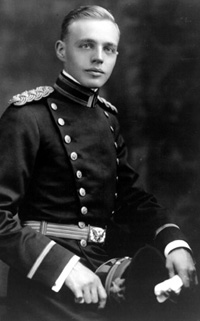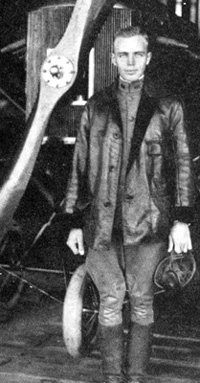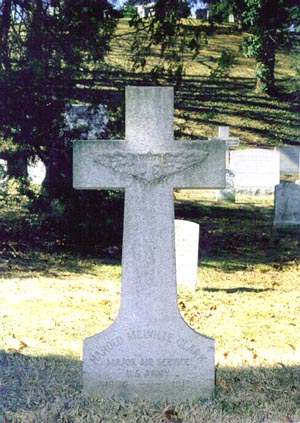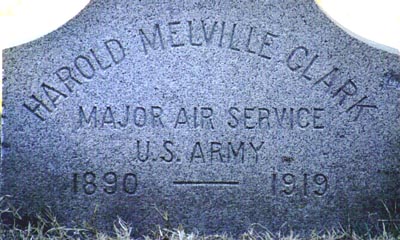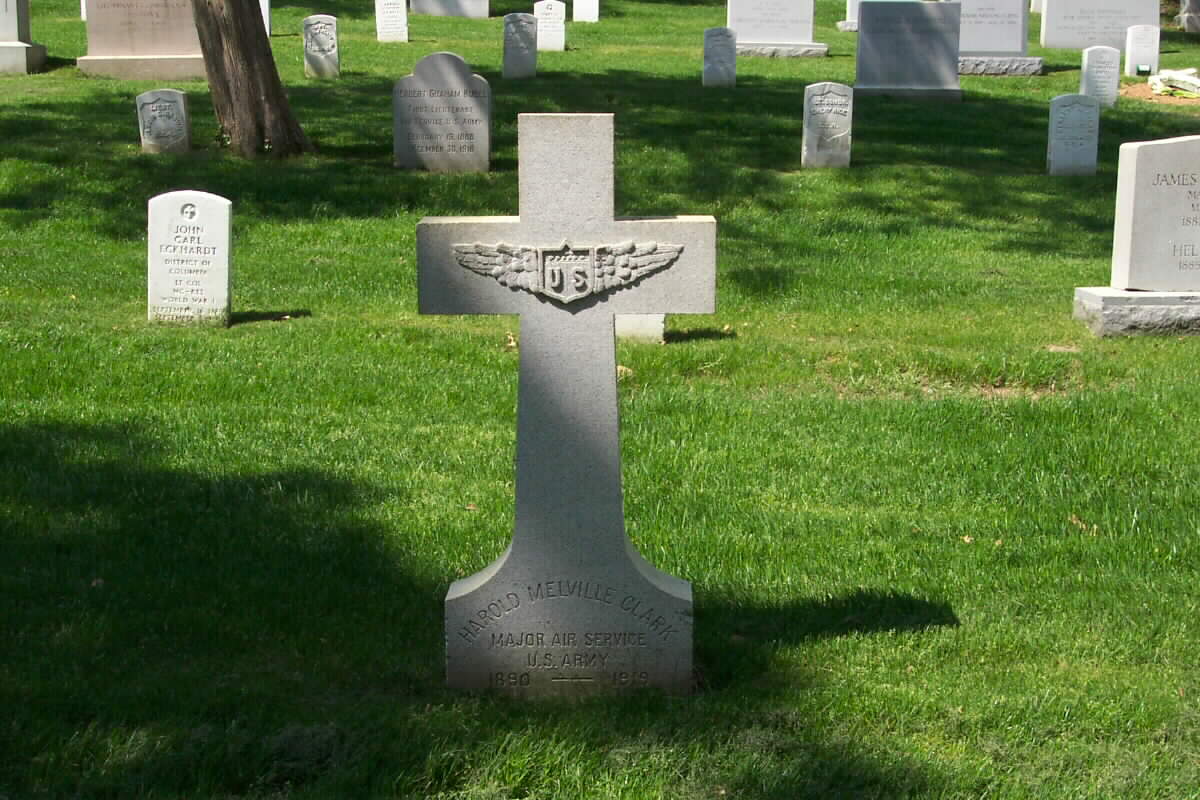Harold M. Clark, Born in 1890 and died on May 2, 1919.
He was the first United States airman to fly in Hawaii. Clark Air Force Base in the Philippines was named for him.
He died on May 2, 1919 in a seaplane crash in the Miraflores Locks, Panama Canal Zone and was buried with full military honors in Arlington National Cemetery.
Wings of the Signal Corps:
the story of Major Harold Melville Clark
by Captain Kevin Romano, United States Army
September 18, 1947, may not seem like an important day for the Signal Corps or the U.S. Army. However, this date marked the first day the U.S. Air Force began to operate as an independent armed service from the Army. Previously the aviators were part of an aviation section within the Signal Corps.
Forming a separate air force led to events establishing Clark Air Base in the Philippines, thus creating one of only two U.S. military installations named in honor of Signal Corps officers. (The other installation is Fort Greely, Alaska, named after Brigadier General Adolphus Greely.) Clark Air Base was named to pay tribute to Major Harold Melville Clark, an early Signal Corps aviator.
Birth of aviation; pioneering aviators
The events tying a U.S. Air Force base to a Signal Corps officer began much earlier than the Air Force’s birth, since America’s military aviation began in the Signal Corps. In 1892, Greely – who was at that time chief signal officer – created a balloon section within the Signal Corps. As pointed out in The Story of the U.S. Army Signal Corps, this was the “first all-military aeronautical organization in the U.S. Army.” Greely realized the tremendous advantage that balloons could provide in military operations. He saw balloons as being used for signaling and observation as well as fire control for the field artillery.
From this inauspicious beginning, military aviation in the Signal Corps grew continually. In July 1914, Congress created an aviation section within the Signal Corps. With this act of Congress, the Signal Corps was responsible for all Army aviation. This responsibility included balloons, airships, airplanes, training, procurement, maintenance, mission support and research and development. This sole responsibility would stay with the Signal Corps until May 1918, when the aviation section formed its own branch within the Army.
With creation of an aviation section within the Signal Corps in 1914, many famous military aviators share a common heritage with the Signal Corps. Some famous Signal Corps aviators include General Henry “Hap” Arnold, commander of the U.S. Army Air Forces during World War II, and General Claire Chennault, commander of the famed “Flying Tigers” during World War II. But more importantly, Army aviation and the U.S. Air Force owe their heritage to the bravery and foresight of the early Signal Corps aviators. One of these pioneering aviators was Clark.
Clark’s early military career
Harold Melville Clark was born Oct. 4, 1890, to Charles Asa Clark and Amanda Palmer Clark in St. Paul, Minnesota. The Clark family had a strong military tradition dating back to the Revolutionary War. Clark’s older brother, Charles, served as a field-artillery officer with the American Expeditionary Forces in Europe during World War I. His father fought Spanish forces in the Philippines while assigned to Company E, 13th Minnesota Volunteer Infantry, during the Spanish American War of 1898.
The end of the Spanish American War brought a period of growth and interest in the Philippines. Among those who cast their future into those Pacific islands was Clark’s father. In 1904, Charles Asa Clark moved his family to Manila, where they enjoyed considerable wealth and prestige due to the family’s business ventures. During this time, Harold Clark attended the American High School in Manila; he graduated April 1, 1910.
Clark followed in his family’s footsteps and returned to the United States for military training. After being commissioned as a second lieutenant in the cavalry in 1913, his first assignment was with 1st Cavalry Division. In 1916, Clark requested a transfer into the Signal Corps’ aviation section, which had been created just two years earlier. Clark’s request was approved, and with approval Clark transferred to the North Island Flying School in San Diego, Calif. On May 3, 1917, Clark received his rating as a junior military aviator.
Harold Melville Clark shortly after being commissioned a second lieutenant in the cavalry.
In the spring of 1916, Pancho Villa and a band of followers crossed the U.S. border and raided Columbus, N.M. Soon thereafter, Brigadier General John “Blackjack” Pershing was placed in command of the “Punitive Expedition.” The Punitive Expedition’s mission was to safeguard and protect U.S. citizens and property along the border, as well as capture Villa. In an effort to prove the airplane’s military worth, the Army augmented Pershing’s forces with air assets. The 1st Aero Squadron was assigned to support Pershing’s campaign. Shortly after receiving his junior-military-aviator rating, Clark joined 1st Aero Squadron and flew missions from bases at Columbus, New Mexico, Kelly Field, Texas, and Fort Sill, Oklahoma.
Aviation in the Hawaiian Islands
While Clark was getting his Army wings, the Signal Corps’ aviation section and military aviation in general was getting a troublesome start in the Hawaiian Islands. The first Army airplanes, pilots and crews arrived in Oahu in July 1913. The planes were based at Fort Kamehameha, near present-day Hickam Air Force Base.
Lieutenant Harold Geiger, who commanded the aviation assets, arrived in Oahu with “two Curtiss float planes, a Curtiss Aeroplane Company mechanic, 12 enlisted men, canvas hangars and other support equipment,” as William Dorrance wrote in Fort Kamehameha: the Story of the Harbor Defenses of Pearl Harbor. However, Geiger’s aircraft were in poor shape. His flights were limited to short flights in Pearl Harbor and a longer flight to Diamond Head and back to Fort Kamehameha.
Geiger was ordered to cease all flying operations in late 1913. The planes were sold locally, and the engines were sent back to the North Island Flying School. The Hawaiian Islands wouldn’t see any more Army aviation activity until 1917.
On March 13, 1917, 6th Aero Squadron arrived for duty at Fort Kamehameha under the command of Captain John Brooks. However, when the squadron arrived, they did so without airplanes. Brooks was promised two Curtiss N9 seaplanes, but as 1917 wore on the seaplanes hadn’t materialized. In August 1917, a frustrated Brooks sent a memorandum to the Army’s adjutant general detailing 6th Aero Squadron’s activities. The three-page memorandum proposed three recommendations:
Purchase Ford Island as a joint Army and Navy aviation site;
Order 6th Aero Squadron back to the United States so it could be used in the war against Germany;
Assign two more officers to 6th Aero Squadron.
The last recommendation is significant for several reasons. Brooks didn’t feel he could safely fly a seaplane if the planes did actually arrive in Oahu. In his memorandum he wrote in detail about the lack of flying time he had while serving in Hawaii. It was Brooks’ third recommendation and his complaints about flying time that resulted in Clark becoming 6th Aero Squadron’s commander and the Hawaii Department’s aviation officer.
Clark arrived at Fort Kamehameha November 14, 1917, with the promised Curtiss N9 seaplanes. He faced the formidable task of learning to fly in the Hawaiian Islands’ challenging environment as well as training 6th Aero Squadron’s men. Initially he focused his efforts on learning about the islands’ prevailing winds and making short local flights over Oahu. Clark’s flights were much to the delight of residents, who were frequent spectators to his low-level flights over the cities on Oahu.
Within a few months, Clark was prepared to undertake a mission that would earn him a place in the history of the Hawaiian Islands. On March 15, 1918, he flew to Molokai and back to Fort Kamehemeha; this was the first inter-island flight ever made in the Hawaiian Islands. Upon his return to Fort Kamehameha, Clark was heralded as a hero by military and civilians alike.
The next feat Clark accomplished was a three-island flight. On May 9, 1918, Clark and mechanic Sergeant Robert Gray took off from Fort Kamehameha. The flight would initially stop in Maui and continue to the island of Hawaii. Upon landing in Maui, Clark and Gray received an enormous welcome from the island’s residents. From there, the flight resumed to Hawaii, but Clark encountered fog and darkness over the island, causing him to crash in the jungle near Hilo. Two days after the crash, Clark and Gray emerged from the Hawaiian jungle unhurt.
According to Harold Richards in The History of Army Aviation in Hawaii, Clark accomplished another “first” on this flight. He had agreed to deliver two letters from Oahu residents to their relatives on Hawaii. After emerging from the jungle, Clark delivered the letters to their intended recipients. Thus Clark carried the first letters by airmail in the Hawaiian Islands.
The fame Clark achieved from these flights is hard to imagine in a day where coast-to-coast jet flights are common. However, in 1918 Hawaii, Clark’s accomplishments were just short of miraculous. From accounts at the time, we can get an idea of the recognition paid to Clark. “He was the first aviator to fly regularly in the islands and was more than a hero in the eyes of the natives,” Dorrance wrote in Fort Kamehameha. “I remember attending a native luau in his home, and the deference paid him at the time was almost beyond belief.”
Fatal crash in Panama
Following the history-making flights in March and May 1918, Clark continued to make regular flights among the islands. However, he was ordered back to the U.S. mainland Aug. 28, 1918, for pursuit training at the North Island Flying School. Following this, Clark assumed command of Pursuit Group, First Provisional Wing, at Minneola, Long Island, N.Y. Clark commanded this group for only a short time before being ordered to Panama at the end of 1918.
Clark arrived at France Field, Panama, in the fall of 1918. France Field was located near present-day Colon. Clark was assigned to the Panama Canal as executive officer for 7th Observation Group.
On the morning of May 2, 1919, Clark and two other aviators, Lieutenant J.R.L. Hitt and Lieutenant Thomas Cecil Tonkin, left France Field for Balboa in an Army seaplane. While enroute, the plane developed engine problems, but the trio made it to Balboa safely. That same afternoon, the three aviators began the return flight to France Field with Hitt at the controls. Due to the plane’s earlier troubles, the flight followed the Panama Canal at an altitude of 250 feet.
Shortly into the flight, the plane’s engine stopped. Hitt hoped to make Miraflores Lake to set the heavy seaplane down, but the plane crashed into the front of Miraflores Locks at about 5 p.m. The best account of the crash is taken from the May 3, 1919, Panama Star & Herald: “The machine crumpled up like a house of cards, and the three men were thrown into the water of the lock. Lieutenant Tonkin was undoubtedly killed instantly by the twisting timbers of the machine. …Major Clark sank to the bottom of the lock, and it’s not known whether he was killed in the crash or whether he drowned.”
Hitt was severely injured in the crash, but bystanders rescued him. The Panama Star & Herald reported that a diver was sent to retrieve Clark’s body. The Army ruled his death as an accident due to internal injuries caused by “aeroplane traumatism,” according to a Defense Department report on Clark’s death dated May 8, 1919, and awarded his mother $10,000. Clark was buried May 29, 1919, with full military honors at Arlington National Cemetery.
The base that would eventually bear Clark’s name was established in 1902 as Fort Stotensberg. The Army used this installation as a cavalry post following the Spanish American War. During World War II, this base would be pivotal in the Army Air Force’s effort to win the air war against Japan.
Following the end of World War II and creation of the U.S. Air Force in 1947, Fort Stotensberg was renamed Clark Air Base. In its prime, Clark Air Base was the U.S. military’s largest overseas installation at an impressive 156,204 acres. Shortly after its establishment, Clark Air Base would serve as home to 13th Air Force for a number of years. Clark Air Base served the military well during the Korean and Vietnam wars, and it was the first stop of freedom for many returning prisoners of war from Vietnam.
The United States turned over possession of Clark Air Base to the Republic of the Philippines November 26, 1991. Clark Air Base is now an international airport serving the Philippines. Most of the former base’s buildings were turned over to private businesses supporting the international airport.
Captain Romano is an instructor in the Department of Mathematical Sciences at the U.S. Military Academy, West Point, N.Y. Previous assignments have included platoon leader, executive officer and assistant S-3 with 40th Signal Battalion, Fort Huachuca, Ariz.; battalion Signal oficer, 5th Battalion, 5th Air Defense Artillery, in Korea; and commander, Company B, 122d Signal Battalion, Korea. He is a graduate of the U.S. Marine Corps Command and Control Course, Quantico, Va., and holds a bachelor’s degree in mathematics from the University of Utah and a master’s in applied mathematics from Naval Postgraduate School.
Research contributions for this article are attributed to Judith Bowman, U.S. Army Museum of Hawaii; Hawaiian Historical Society; Steve Nielsen, Minnesota State Historical Society; Mitchell Yockelson, National Archives and Records Administration; Tom Utts; U.S. Military Academy library staff; Stuart Warner, U.S. Army South; and Rolando Lara, Panama Canal Authority
Harold Melville Clark As A Newly Appointed
Second Lieutenant of Cavalry
U. S. Army Photo
Harold Melville Clark In Aviation
Training At San Diego, California
U. S. Army Photo
CLARK, HAROLD M
MAJOR AIR SERVICE USA
VETERAN SERVICE DATES: Unknown
DATE OF DEATH: 05/02/1919
DATE OF INTERMENT: Unknown
BURIED AT: SECTION S DIV SITE LOT 4222
ARLINGTON NATIONAL CEMETERY
Michael Robert Patterson was born in Arlington and is the son of a former officer of the US Army. So it was no wonder that sooner or later his interests drew him to American history and especially to American military history. Many of his articles can be found on renowned portals like the New York Times, Washingtonpost or Wikipedia.
Reviewed by: Michael Howard

